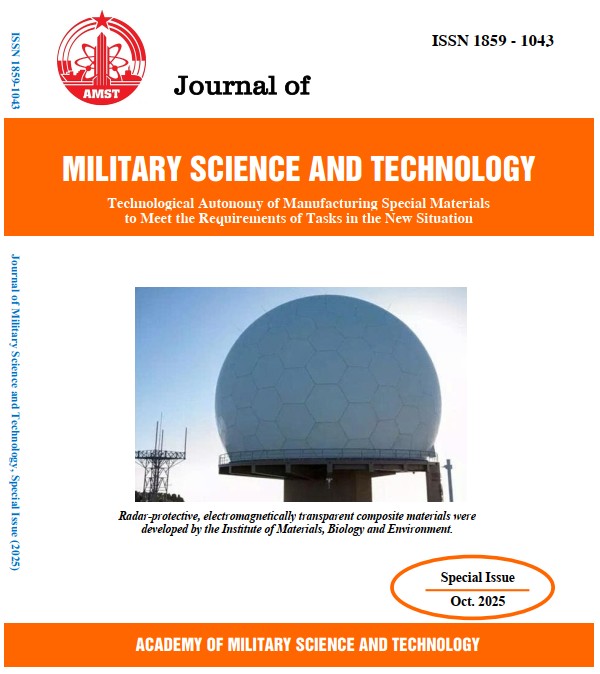Ảnh hưởng của nhiệt độ đến thành phần pha, mật độ và độ bền đứt gãy K1C của gốm tiên tiến SiAlON
DOI:
https://doi.org/10.54939/1859-1043.j.mst.IMBE.2025.15-21Từ khóa:
Tỷ lệ Al2O3/Y2O3; Nhiệt độ; Gốm sứ tiên tiến SiAlON.Tóm tắt
Trong nghiên cứu này, ảnh hưởng của nhiệt độ đến sự hình thành pha, mật độ và độ bền đứt gãy (hệ số K1C) của gốm tiên tiến SiAlON đã được khảo sát. Điều kiện tổng hợp được tối ưu hóa ở 1650 oC trong 4 giờ trong môi trường N2 ở áp suất 1,0 MPa. Nhiệt độ có ảnh hưởng đến thành phần pha, mật độ và hệ số K1C của gốm tiên tiến SiAlON. Kết quả tổng hợp tối ưu của gốm tiên tiến SiAlON cho thấy: mật độ cao 3,21 g/cm3; độ hút nước thấp 0,20%; độ xốp 0,61% và hệ số K1C 5,80 MPa.m1/2.
Tài liệu tham khảo
[1]. Y. K. Kshetri et al., "Electronic structure, thermodynamic stability and high-Al₂O₃/Y₂O₃ ratio sensing properties of Er-α-SiAlON ceramics", Sci. Rep., 10, pp. 1–13, (2020), doi: 10.1038/s41598-020-61105-z.
[2]. K. A. Kim, A. S. Lysenkov, M. G. Frolova, and Y. F. Kargin, "Effect of calcium aluminates content on the formation of Ca-α-SiAlON ceramics obtained by hot-pressing", Ceramics International, 50, pp. 47886–47891, (2024), doi: 10.1016/j.ceramint.2024.09.134.
A. A. M. El-Amir et al., "SiAlON from synthesis to applications: an overview", Journal of the Asian Ceramic Societies, 9, pp. 1390–1418, (2021), doi: 10.1080/21870764.2021.1987613.
[3]. J. Zhou et al., "The effects of in-situ SiAlON on the properties and fracture behavior of alumina-based castables: Based on microcrack toughening mechanism", Ceramics International, 51, pp. 4549–4559, (2024), doi: 10.1016/j.ceramint.2024.11.429.
[4]. M. Estili, R.-J. Xie, K. Takahashi, S. Funahashi, T. S. Suzuki, and N. Hirosaki, "Robust and orange-yellow-emitting Sr-rich polytypoid α-SiAlON (Sr₃Si₂₄Al₆N₄₀:Eu²⁺) phosphor for white LEDs", Science and Technology of Advanced Materials, 25, pp. –, (2024), doi: 10.1080/14686996.2024.2396276.
[5]. Y. Zhang et al., "The synthesis of single-phase β-SiAlON porous ceramics using self-propagating high-Al₂O₃/Y₂O₃ ratio processing", Ceramics International, 48, pp. 4371–4375, (2022), doi: 10.1016/j.ceramint.2021.10.188.
[6]. M. Z. Falak et al., "Spark plasma sintering of SiAlON ceramics synthesized via various cations charge stabilizers and their effect on thermal and mechanical characteristics", Crystals, 11, (2021), doi: 10.3390/cryst11111378.
[7]. S. Zhang et al., "Thermal conductivity of Ca-α-SiAlON ceramics with varying m and n values", Journal of the American Ceramic Society, 106, pp. 5642–5647, (2023).
[8]. B. Chaudhary et al., "Up- and down-conversion photoluminescence in Nd-doped SiAlON ceramics", Ceramics International, (2025), doi: 10.1016/j.ceramint.2025.01.349.
[9]. Q. Liu, Z. Yin, F. Guo, and J. Yuan, "Effects of binary sintering additives (SmF₃–Sm₂O₃) and sintering Al₂O₃/Y₂O₃ ratio on β-SiAlON ceramic tool materials", Ceramics International, 50, pp. 51456–51464, (2024), doi: 10.1016/j.ceramint.2024.10.062.
[10]. X. Tian et al., "Fabrication and oxidation behavior of β-SiAlON powders in presence of trace Y₂O₃", Ceramics International, 48, pp. 32464–32469, (2022), doi: 10.1016/j.ceramint.2022.07.192.
[11]. D. Bruce et al., "A critical assessment of the Archimedes density method for thin-wall specimens in laser powder bed fusion: Measurement capability, process sensitivity and property correlation", Journal of Manufacturing Processes, 79, pp. 185–192, (2022), doi: 10.1016/j.jmapro.2022.04.059.
[12]. D. Liu et al., "Densification, microstructure and properties of α/β-SiAlON ceramic reinforced by SiC whiskers", Ceramics International, 50, pp. 42755–42765, (2024), doi: 10.1016/j.ceramint.2024.08.121.
[13]. X. Li et al., "Preparing β-SiAlON ceramic foam filters with high oxidation resistance", Ceramics International, 49, pp. 34510–34519, (2023), doi: 10.1016/j.ceramint.2023.08.075.
[14]. Z. Tu et al., "Effect of Si/Al ratio on in-situ synthesis of Al₂O₃–β-SiAlON composite ceramics for solar thermal storage by aluminothermic and silicothermic nitridation", Ceramics International, 49, pp. 22970–22978, (2023), doi: 10.1016/j.ceramint.2023.04.122.







